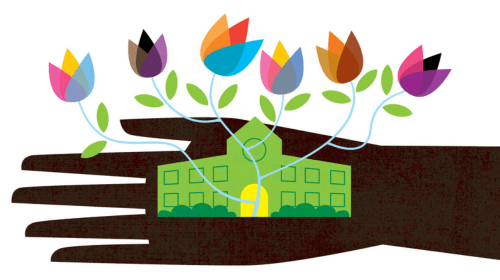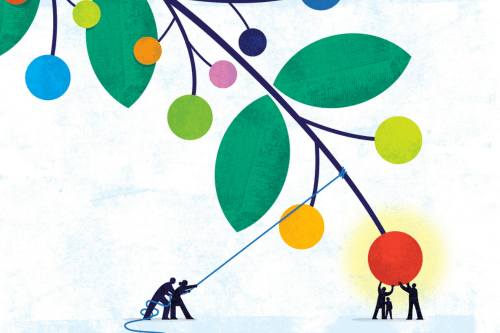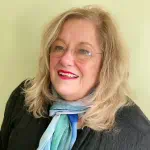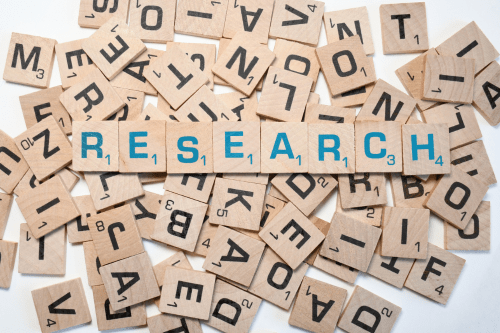Action research is “practitioner-based research…. Action research is characterized by research that is done by teachers for themselves. [It] allows teachers to study their own classrooms—for example, their own instructional methods, their own students, and their own assessments—in order to better understand them and to be able to improve their quality or effectiveness.”

This article was featured in our 2024 Spring edition of Montessori Life magazine. Read the full issue online (AMS members only).
AMS members also receive a print subscription to Montessori Life magazine. Become a member today to receive your own subscription plus access to the complete digital archives.
Maria Montessori became an action researcher as soon as she began developing her first Casa dei Bambini. “As soon as I knew I had at my disposal a class of little children, it was my wish to make of this school a field for scientific experimental pedagogy
and child psychology” (Montessori, 2008, p. 69). Montessori modeled and laid the foundation for all of us to carefully observe, reflect on our observations, plan for positive change, implement a plan, and then start the cycle again: Observe and evaluate the outcome, and reflect, plan, etc. Through this cycle, she was modeling what it means to be a reflective practitioner—open to positive change in order to effectively meet the learning needs of her students.
For example, Montessori observed that children displayed delight and peace after a discovery with a material, and that this drove them to repeat the work again and again. She reflected on her observation and noted that movement, especially movement of the hand, plays a most important part in the mental development of young children. “Little children revealed that the development of the mind is stimulated by the movement of the hand” (Montessori, 2012, p. 16). The “plan” that ensued from Montessori’s observations included more hands-on materials, choice, and a long work period in which to explore. This systematic planning and implementation led to curriculum development and, ultimately, the creation of her teaching method. We know from Montessori’s writings that she considered the action research tool so important that it became part of her teacher education and mentoring. Montessori also modeled a spectrum of employing action research that we Montessorians follow: We use research to make major decisions about the environment or teaching strategies, but we also use these same steps as we observe each child, make plans (including lessons and environmental preparation that will help to meet the child’s learning needs), observe the child’s learning, reflect, and repeat the cycle. “We must make a plan of development guided by the child through the power that it reveals. We must proceed not on the basis of our own ideas or our
own prejudices, not on preconceived methods, but by observing the child” (Montessori, 2012, p. 12).
Montessori also modeled using action research as a tool to create and sustain a climate of peace. Many of the practices she exhibited and strengthened through the action research process were foundations for peaceful coexistence, and for our more modern framework of diversity, equity, and inclusion. Firstly, Montessori advocated for teachers to support children in their developing autonomy and their formation of agency. Her curriculum for Early Childhood was designed to engage children in wonder at the extraordinary natural world, and in Elementary, to facilitate their discovery of connections and study of change agents, leading to them assuming their own roles as change agents for justice. Montessori’s action research also led to her discovery of the methodology of differentiated instruction, in a rich learning environment, with lessons to support individual learning. Differentiated instruction and a curriculum with ample choice are also keys to equity-based instruction and assessment: They support each learner in reaching their potential. Montessori’s action research led to her advocating for collaboration in Elementary classrooms rather than the competition that had so long been an integral part of classrooms. Her work demonstrated that an environment that invites collaborative problem-solving can be both caring and peaceful. It also aligns with the more recently outlined four goals of anti-bias education as laid out by Louise Derman-Sparks and Julie Olsen Edwards: identity, diversity, justice, and activism (2009). Montessori modeled nurturing humans who work for social justice by learning to respect themselves (identity), respect others (diversity), respect their physical and social environment (justice), and build agency that will ultimately enable them to make positive change for equity and inclusion (activism).

I have been doing action research in my classrooms (and mentoring teachers on action research) for nearly 30 years, ever since the 1990s when I joined one of the Teacher’s Research Network cohorts facilitated by John Chattin-McNichols in collaboration with Peggy Loeffler. These days, I find that teachers are increasingly electing to use action research not only to solve problems but to make their classrooms and schools more peaceful and inclusive: more community-oriented. Montessori’s work and writings laid the foundation for these community-oriented environments, but we need to constantly review our practices and curriculum to ensure that we meet the needs of our diverse learners in an increasingly complex world in urban, suburban, rural, public, and private settings. As Peggy Loeffler challenged us in a 2001 article (reprinted in this magazine in 2023): “We must develop a new attitude among ourselves that says it’s all right to reexamine Montessori’s ideas in light of new things that are learned” (2023, p. 47). That is what our Montessori teachers are doing—using action research to make positive changes in their classrooms while preserving the pedagogy’s foundations. Action research realizes Montessori’s vision for peace in the contemporary world by helping teachers find ways to be culturally responsive practitioners who nurture valuing oneself, others, and the environment, and who inspire action for positive change.
We all realize that a strength of Montessori is teaching as children learn—in a purposeful way that illuminates the interconnectedness of all domains for young children and of all disciplines for older learners. Thus, a change in environment or curriculum or communication can often impact the entire learning experience of children.
For example, Abby (Akkerman, 2014) was concerned about some of the “distracting movement” and lack of focus of the students in her Early Childhood public school setting. She wanted to give her students more independence and to have her classroom be more joyful and peaceful. Her implementation plan was to introduce a movement shelf so that when children felt a need to move, they could choose a purposeful movement activity (first introduced in a lesson) that varied from line walking to hopping to yoga poses, etc. After implementing the movement shelf, the transformation of her classroom was dramatic, with the agency moving from the teacher to the children.
Markell (Lockwood, 2014) wanted the students in her Elementary I public school classroom to be able to more positively support each other, with the end goal of creating a more peaceful and empathetic community where students understood their own self-worth. To achieve this, she implemented a peace program. She first helped children learn a vocabulary of virtues, to begin an awareness that there were many ways to be “good.” She then had the students draw a secret pal each Monday; students would observe their pals throughout the week, and then, at a Friday meeting, they would share a behavior they’d seen that contributed positively to their community. Children would also do an anonymous special act for their pals during the week. Markell’s observations revealed a great increase in the use of a vocabulary of kindness as well as more caring behavior, peer tutoring, and expressions of peace in artwork and writing. Action research always builds on itself, creating new plans of action. In Markell’s classroom, once students had established a caring community within their own walls, they were ready to make change in the broader community and took on service learning projects. This work also prepared them for further outreach, like the Montessori Model United Nations program, when they moved up to Elementary II.
Nichole (Smith, 2021) was concerned about her Elementary I students’ lack of engagement in reading, and also about their limited awareness of diverse cultures. She aimed to improve both by immersing her students in rich literature experiences (via shared reading and writing work) and other experiential language activities that highlighted both social justice and multiculturalism. This plan led to transformation. While out on a GPS quest to practice longitude and latitude, the students came upon an encampment of unhoused individuals. They were deeply moved by this encounter and wanted to know much more about the people they had seen. To answer their questions, they interviewed the directors of two homeless shelters in their city, using the new language they’d learned to both draft questions and then write about their findings. The experience also increased their sense of agency. Inspired by shared reading of the book Malala’s Magic Pencil by Malala Yousafzai, they decided to provide help to unhoused individuals by writing letters, knitting warm hats, and cooking for them. Another inspiring shared reading, One Plastic Bag by Miranda Paul, prompted a class environmental cleanup and recycling project. These books and others Nichole introduced became favorite selections at silent reading time, and the class was alive with readers and writers. Providing learning experiences guided by the Cosmic curriculum resulted in an engaging environment where lessons in reading and writing found purposeful application, as students explored the big concept of social justice and found that they could make change.
As I’ve mentored Montessori teachers at the Secondary level, I have realized that the diversity/inclusion/equity thread in our pedagogy incorporates more than respecting and valuing ourselves, others, and the environment. It is more than learning and connecting with other peoples and cultures. It is even more than providing students an opportunity and models for having agency and a voice. By consistently giving ownership to learners who set goals and offering choice as to how these goals are met, we are modeling and practicing equity-based teaching. For example, two Middle School teachers were dismayed by their students’ lack of self-agency in mathematics. After an enormous amount of environmental preparation with numerous shelf activities, Christine (Highland, 2015) turned her math class into an individual self-paced module, with lessons provided as requested. All of the students covered more units independently than they would have as a whole class. Tealie (Krugerud, 2015), another math teacher, continued to teach in groups to differentiate instruction, but she offered far more choice and more case studies for students to solve collaboratively. She noted an improvement in math assessment scores as well as in student motivation. A third Middle School teacher, Kent (Miller, 2015), used Socratic seminars to engage his students in art appreciation and analysis. He modeled asking questions and gradually turned the questioning over to the students; as a result, they became familiar with examining all the elements of art, gained responsibility, and were motivated to learn. Christine, Tealie, and Kent all found tools to maximize the learning of all their students. This is equity-based instruction as modeled by Maria Montessori, adapted to a 21st-century context.

When each of these teacher researchers presented their work to me, I realized having the researcher at the center of the action research investigation creates a hidden variable: As each identified a problem and sought to change it, they were asking themselves if they were part of the problem and if they could act differently to be part of the solution. In all these case studies, the teacher’s self-reflection was instrumental in inspiring positive change, including defining their own changes as a variable in the implementation plan. Maati Wafford, the director of equity and engagement of AMS, has offered some specific questions that I encourage all Montessori action researchers to integrate into their work. My hope is that rather than sharing their reflections as an aside, teachers will incorporate them into the action research and change process, as Wafford suggests.
I have worked with AMS’s Emerging Leaders program and, in reviewing the school-based action research projects of the program participants, I have learned that we also need to work on reexamining how Montessori philosophy and pedagogy supporting social justice can be applied not only to our students but to our faculty and adult learners. Some Emerging Leaders have worked on building communities in which children, staff, and parents all have active roles. Others have worked on inter-
school communication—giving every stakeholder a voice. Still others have strengthened the social justice learning in their classrooms—whether through service learning, children’s literature, peer tutoring, and/or better scaffolding for inclusion of children with learning differences. Kristen Brey (2020) and her colleagues defined a goal to work on equity, diversity, and inclusion in all their classrooms to create more just classrooms and a window to a wider world. However, they realized that they needed to self-educate—to identify their own beliefs and biases so they could better guide their students—before they could talk about how to enhance their teaching methods and curriculum to achieve this goal. Kristen led her colleagues in an ABAR self-exploration and collaborative goal-setting journey using the book Me and White Supremacy by Layla Saad as a framework. (Another current resource to consider for a continuation of this work is Equity Examined: How to Design Schools and Teacher Education Programs Where Everyone Thrives (AMS, 2023)).
Maria Montessori, the educator and scientist, modeled the use of action research as a humanistic tool to keep her pedagogy dynamic. We have ample evidence to assure us that the foundations of our Montessori pedagogy are sound. However, curriculum content and teaching strategies must be continually researched to ensure we are being responsive to and supportive of all learners in our care. As we strive to become more cognizant of ways to make our learning environments more diverse, equitable, and inclusive, we must learn to observe ourselves and others through a lens of diversity, equity, and inclusion, and then examine our Montessori settings, methods, curriculum content, and relationships to ensure that we continue to value ourselves, others, and the environment, and have the capacity to be kind and caring as we work for real change. Action research is a tool for this great work of transformation to achieve social justice.
References
Akkerman, A. (2014). Benefits of movement in a Montessori classroom on children’s behavior and focus. [Master’s thesis, University of Wisconsin–River Falls]. https://amshq.org/wp-content/uploads/2025/01/Benefits-of-Movement-in-a-Montessori-Classroom-on-Childrens-Behavior-and-Focus.pdf
American Montessori Society. (2023). Equity examined: How to design schools and teacher education programs where everyone thrives. BookBaby.
Brey, K. (2020). Unpublished AMS Emerging Leaders capstone project.
Derman-Sparks, L., & Olsen Edwards, J. (2009). Anti-bias education for young children and ourselves. NAEYC.
Highland, C. (2015). Self-paced individualized learning. [Master’s thesis, University of Wisconsin–River Falls]. https://amshq.org/wp-content/uploads/2025/01/Self-Paced-Individualized-Learning.pdf
Krugerud, T. (2015). Benefits of choice in a Montessori classroom on student’s behavior and focus. [Master’s thesis, University of Wisconsin–River Falls]. https://amshq.org/wp-content/uploads/2025/01/Benefits-of-Choice-in-a-Montessori-Classroom-on-Students-Behavior-and-Focus.pdf
Lockwood, M. (2014). Incorporating peace education into the school curriculum: Building empathy and self-worth while taking ownership over peace. [Master’s thesis, University of Wisconsin–River Falls]. https://amshq.org/-/media/Files/AMSHQ/Research/Action-Research/Incorporating-Peace-Education-into-the-School-Curriculum.pdf
Loeffler, M. H. (2023). Unfolding Montessori’s ideas in today’s society. Montessori Life, 34(4), 46–49.
Mertler, C. A. (2016). Action research: Improving schools and empowering educators (5th ed.) Thousand Oaks, CA: Sage.
Miller, K. (2015). Visual literacy and Socratic seminars in a secondary Montessori classroom. [Master’s thesis, University of Wisconsin–River Falls]. https://amshq.org/wp-content/uploads/2025/01/Incorporating-Peace-Education-into-the-School-Curriculum.pdf
Montessori, M. (2008). The Montessori method. BN Publishing.
Montessori, M. (2012). The 1946 London lectures. Montessori-Pierson Publishing Co.
Saad, L. F. (2020). Me and white supremacy: Combat racism, change the world, and become a good ancestor. Sourcebooks.
Smith, N. S. (2021). Literacy engagement and the impacts on literacy development. [Master’s thesis, University of Wisconsin–River Falls].
Suggested Reading
Hammond, Z. (2015). Culturally responsive teaching and the brain: Promoting authentic engagement and rigor among culturally and linguistically diverse students. Corwin, a SAGE Company.
About the Author
 |
Gay Ward, PhD (she/her), is the AMS 2024 Living Legacy. She is professor emerita at the University of Wisconsin–River Falls (UWRF), where she works as a Montessori consultant and academic faculty in teacher education and Montessori studies. She is AMS-credentialed (Elementary I) and has taught in the United States and Australia. She helped develop the world’s first Montessori doctoral program (at UWRF). Contact her at gay.ward@uwrf.edu |
Interested in writing a guest post for our blog? Let us know!
The opinions expressed in Montessori Life are those of the authors and do not necessarily represent the position of AMS.



